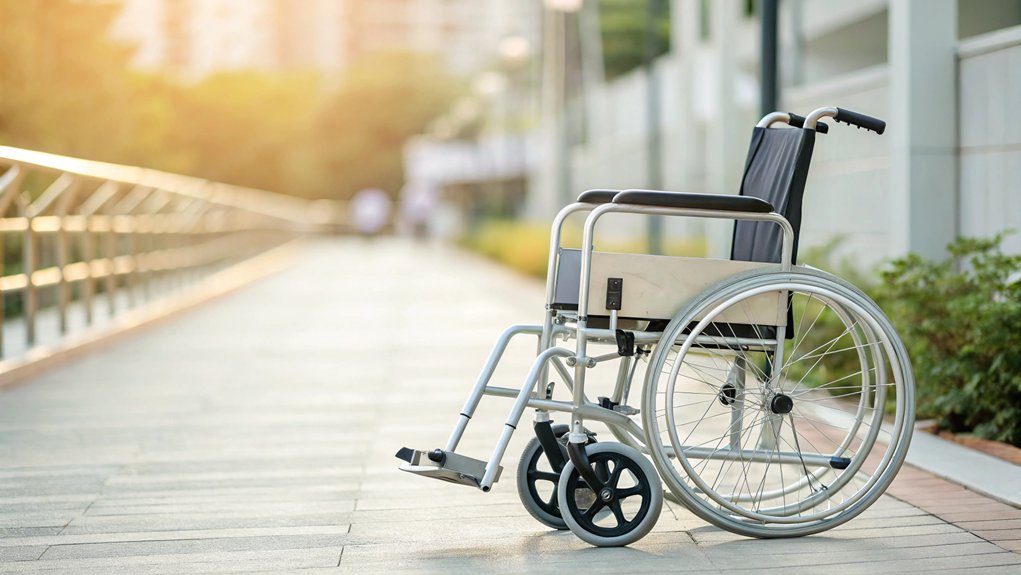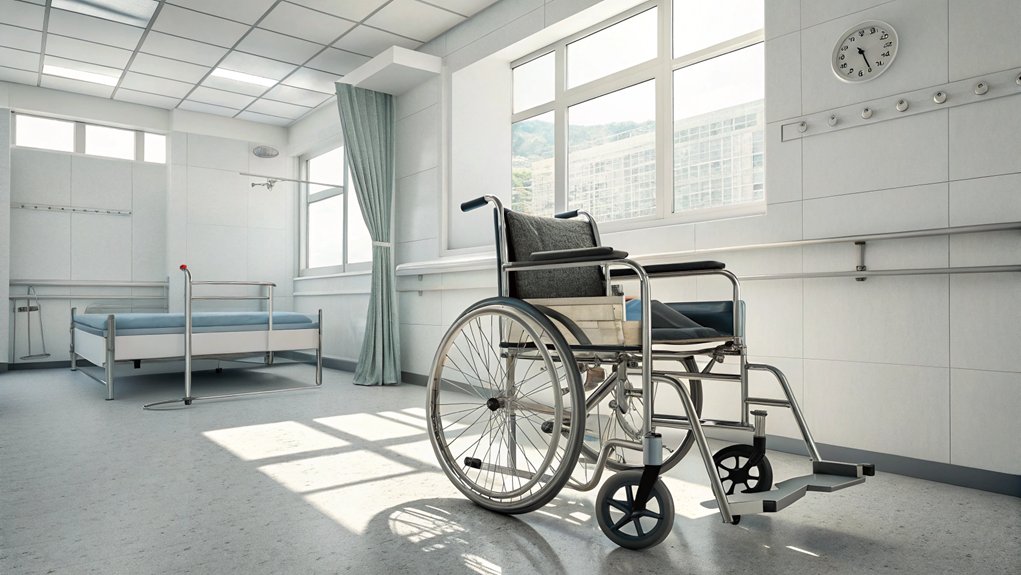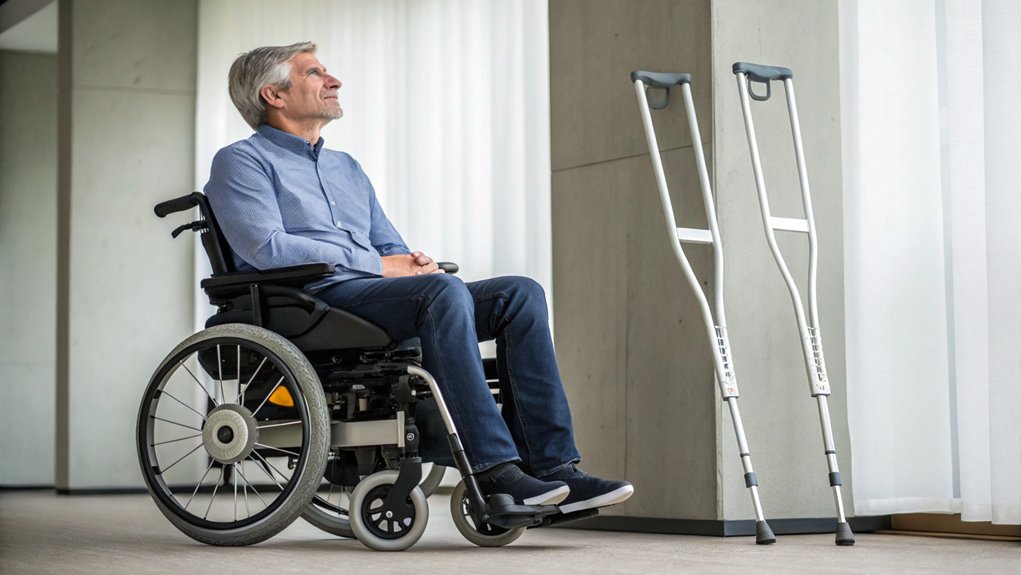
Medicare covers medically necessary mobility aids, like wheelchairs, to help improve your independence and quality of life. To qualify, you’ll need a doctor’s prescription explaining your mobility needs. Medicare Part B usually pays 80% of the approved costs after the deductible, while you cover 20%. It’s essential to choose an approved supplier to guarantee coverage. Understanding the process can feel overwhelming, but there’s much more to uncover about how to navigate your wheelchair options and support.
Main Points
- Medicare Part B covers medically necessary wheelchairs prescribed by a doctor, addressing specific mobility needs.
- Patients are responsible for a 20% coinsurance after the Part B deductible is met.
- A signed Certificate of Necessity from a doctor is required to confirm medical need and specify wheelchair type.
- Wheelchairs must be obtained from a Medicare-approved supplier to ensure coverage eligibility.
- If coverage is denied, patients can appeal the decision using a Redetermination Request Form or a written appeal.
Overview of Medicare Coverage for Wheelchairs

When you face mobility challenges, understanding Medicare coverage for wheelchairs can make a significant difference in maintaining your independence. Medicare Part B covers medically necessary wheelchairs prescribed by a doctor, provided you have a qualifying health condition that restricts your movement. If you struggle to perform daily activities, even with standard mobility aids, you may qualify for coverage.
Medicare typically covers 80% of the approved amount after the Part B deductible is met, leaving you responsible for a 20% coinsurance. It’s essential to obtain your wheelchair from an approved supplier that accepts Medicare, as this guarantees your coverage aligns with the program’s guidelines. Your doctor must specify the type of wheelchair needed—be it a manual, power scooter, or power wheelchair—making sure you get the right support for your needs. Understanding these steps can empower you to navigate your options confidently.
Types of Wheelchairs Covered by Medicare
When considering your mobility needs, it’s important to know that Medicare covers various types of wheelchairs to suit different abilities. Whether you’re looking at manual wheelchairs for self-propelling or power mobility devices for more support, understanding your options can help improve your quality of life. Let’s explore these choices together and find the right fit for your needs.
Manual Wheelchairs Overview
Understanding your options for mobility aids can be overwhelming, especially when steering through Medicare coverage for manual wheelchairs. If you’ve got mobility limitations and can self-propel, but can’t safely use canes or walkers, Medicare may cover a manual wheelchair if there’s a medical necessity. To qualify, you’ll need a signed Certificate of Necessity from your primary care provider, detailing how your condition affects daily living activities. Medicare typically covers 80% of the approved amount after meeting the Part B deductible, leaving you with a manageable 20% coinsurance. Remember, it’s essential to obtain your wheelchair from approved suppliers to guarantee your coverage is honored. You’re not alone in maneuvering this process—support is available!
Power Mobility Devices
Managing mobility challenges can be intimidating, and finding the right support is key to maintaining independence. If you have a medical condition or injury that affects your mobility, you might be eligible to receive Medicare coverage for power mobility devices like power wheelchairs and scooters. To qualify, you’ll need a Certificate of Necessity from your doctor after a face-to-face evaluation, confirming the equipment’s medical necessity for your home environment. Make certain to use the right supplier approved by Medicare, as this guarantees your approval from Original Medicare. Remember, certain power wheelchairs and scooters may require prior authorization, so it’s essential to stay informed and prepared throughout the process. Your mobility deserves the best support available.
Steps to Obtain a Wheelchair Through Medicare

Obtaining a wheelchair through Medicare can feel overwhelming, but breaking the process down into manageable steps makes it easier. Start with a face-to-face meeting with your primary care provider to discuss your mobility needs and assess your eligibility for the equipment. After the assessment, your doctor will need to provide a signed Certificate of Necessity that outlines the specific type of wheelchair you’ll require.
Next, choose a wheelchair supplier approved by Medicare; they must meet Medicare guidelines to guarantee seamless reimbursement. Remember, with Medicare Part B, you’ll typically have 80% coverage after your deductible, leaving you responsible for 20% coinsurance. Finally, if your coverage is denied, you have the right to appeal by submitting a Redetermination Request Form or writing an appeal within the specified timeframe. Taking these steps helps you navigate the process with confidence and clarity.
Cost and Payment Structure for Wheelchairs
Understanding the cost and payment structure for wheelchairs under Medicare is essential for securing the mobility aid you need. You’ll find that Medicare covers 80% of the approved amount, whether you choose to rent or purchase. However, it’s important to be aware of potential out-of-pocket costs and the necessity of working with approved suppliers to guarantee you’re fully supported.
Medicare Coverage Percentage
When it comes to wheelchair coverage under Medicare, knowing that you’ll typically pay only 20% of the costs after meeting your deductible can ease some financial worries. Medicare Part B offers coverage for one piece of medical equipment, like a manual wheelchair. Your primary care provider (PCP) must order it, and that order should say whether you want to rent or purchase. It’s essential to choose an approved supplier, as coverage can vary based on the type of wheelchair and supplier. Although Medicare covers 80% of costs, be mindful of potential out-of-pocket costs for any items that aren’t covered or if your claims face denial due to insufficient documentation. Understanding these details can greatly impact your experience.
Rental vs. Purchase Options
Steering the decision between renting and purchasing a wheelchair under Medicare can feel overwhelming, especially when finances come into play. With Medicare Part B, your expenses will typically be covered at 80% after meeting the deductible. For rental options, you’ll pay 20% coinsurance on monthly fees until ownership transfers after 13 months. This can be appealing as it allows you a trial period with the manual wheelchair. However, with purchase options, you’ll need to weigh upfront costs and future maintenance. Consulting your primary care provider (PCP) can clarify coverage rules and which mobility aids suit you best. Remember, once ownership transfers, you’ll be responsible for repair costs beyond your initial coinsurance. Choose what’s right for your situation!
Out-of-Pocket Costs
Managing the out-of-pocket costs for wheelchairs under Medicare can feel overwhelming, especially when considering how it fits into your overall budget. Once you meet the Medicare Part B deductible, you’re responsible for 20% of the approved amount for your wheelchair or scooter. Medicare offers payment options to ease this burden: you can rent for 13 months, where monthly fees are covered at 80%, or make a one-time purchase. However, the total out-of-pocket cost can vary based on the wheelchair type, its approved amount, and any extra supplier charges. To further alleviate costs, consider Medicare Supplement plans, which may assist with out-of-pocket expenses related to wheelchair coverage, helping you gain mobility without financial strain.
Appeals and Additional Help for Wheelchair Coverage
If you’ve recently faced a denial from Medicare for your wheelchair coverage, know that you’re not alone, and there are steps you can take to seek the help you need. Here’s how to navigate the appeals process and regain your Medicare coverage for one:
- Review the Medicare Summary Notice (MSN) for the reason behind your coverage denial.
- Gather necessary documentation to prove medical necessity; this is vital for durable medical equipment like a wheelchair.
- Submit a Redetermination Request Form or a written request to provide additional evidence.
- Ensure timely submission—you typically have 120 days from the MSN date.
It’s important to follow all documentation requirements, especially if prior authorization was needed. Remember, many Medicare Supplement plans can help cover out-of-pocket costs associated with coverage denials, easing your financial burden. You’re not alone in this journey!
Medical Necessity Criteria

When evaluating the medical necessity for a wheelchair, your doctor plays an essential role in understanding your unique needs and the challenges you face in daily living. To qualify for wheelchair coverage under Medicare Part B, you must show that alternative mobility aids, like canes or walkers, aren’t enough. Your primary care provider will assess your ability to perform activities of daily living, emphasizing the limitations you encounter. A signed Certificate of Necessity is vital; it should specify the conditions motivating your need for a wheelchair, whether it’s a manual or power wheelchair. If you’re requesting a power wheelchair, the doctor’s order must highlight your inability to safely operate a manual wheelchair. Understanding this medical necessity guarantees that you receive the appropriate mobility aid to enhance your independence and quality of life.
Supplier Selection
Choosing the right supplier for your wheelchair is essential for making sure you receive the mobility aid you need to maintain your independence. When taking supplier selection into account, keep these key points in mind:
Selecting the proper wheelchair supplier is crucial for ensuring your mobility and independence.
- Verify Approval: Confirm your supplier is approved by Original Medicare or your Medicare Advantage Plan for coverage eligibility.
- Check Credentials: Confirm the supplier complies with Medicare guidelines to guarantee that the wheelchair is classified as durable medical equipment (DME).
- Understand Medical Necessity: The order must clearly identify the type of wheelchair prescribed and the medical conditions necessitating its use.
- Visit a Face-to-Face Office: It’s beneficial to meet with your primary care provider (PCP) to discuss prescriptions and receive guidance on which approved suppliers to evaluate.
Medicare Coverage Limitations

Maneuvering through Medicare coverage can feel overwhelming, especially when it comes to understanding the limitations surrounding mobility aids. Medicare coverage limitations restrict you to equipment deemed medically necessary for managing specific conditions at home. You can only receive coverage for one piece of mobility equipment at a time, often requiring clear physician documentation that details your needs.
During your face-to-face visit, your doctor must illustrate that alternative mobility aids, like walkers or canes, aren’t sufficient for your daily living activities. Only then can you qualify for wheelchair coverage. It’s essential that the prescribed wheelchair and the supplier you choose are approved by Original Medicare or your Medicare Advantage Plan to guarantee smooth reimbursement.
Understanding these nuances helps you navigate the system effectively, confirming you get the support you truly need. Don’t hesitate to ask your healthcare provider for guidance through this process.
Frequently Asked Questions
Are Mobility AIDS Covered by Medicare?
Yes, mobility aid benefits are available through Medicare, but coverage limitations explained require understanding the eligibility criteria overview. Following the medicare approval process guarantees successful claims submission, while user experiences shared help clarify common misconceptions.
What Disabilities Automatically Qualify for Medicare?
You won’t find specific automatic qualification criteria for disabilities under Medicare. Instead, types of disabilities vary; qualifying conditions often need health condition assessments and disability documentation requirements to determine your eligibility and mobility impairment options compassionately.
How Do You Qualify for a Mobility Chair?
To qualify for a mobility chair, you’ll need physician documentation emphasizing your challenges. Understanding eligibility requirements, a prescription necessity overview, and coverage limitations outlined can help. Also, consider chair features and maintenance for ideal use.
How to Get Orthotics Covered by Medicare?
To get orthotics covered, guarantee you have a physician’s prescription, meet qualifying criteria, and choose approved orthotic suppliers. Understand coverage limitations and follow the reimbursement process; don’t hesitate to explore alternate funding and the appeal process if necessary.
Conclusion
Maneuvering Medicare for mobility aids can feel overwhelming, but you’re not alone in this journey. Understanding what’s covered, the qualifying criteria, and the process to secure a wheelchair can make all the difference in maintaining your independence. Remember, it’s essential to communicate openly with your healthcare provider and explore your options. With the right support, you can find the mobility aid that meets your needs and enhances your quality of life. Don’t hesitate to ask for help along the way.
